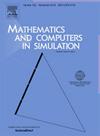An interpolation scheme with C1 Overhauser-type interpolation splines over hierarchical T-meshes
IF 4.4
2区 数学
Q1 COMPUTER SCIENCE, INTERDISCIPLINARY APPLICATIONS
引用次数: 0
Abstract
We present a surface interpolation scheme employing a kind of Overhauser-type interpolation splines over hierarchical T-meshes. The introduced spline surfaces exhibit continuity and possess the capability to interpolate all basis vertices within hierarchical T-meshes, making them well-suited for surface modeling applications. Initially, we develop a set of linearly parametrized basis surfaces over hierarchical T-meshes. Furthermore, through the blending of the basis functions with these linearly parametrized basis surfaces, we propose Overhauser-type interpolation splines over hierarchical T-meshes. Examples are provided to demonstrate the comparison of interpolation performance between PHT-splines and Overhauser-type interpolation splines. The Overhauser-type interpolation splines exhibit good properties such as affine invariance, interpolation property, and continuity. Some experiments on surface reconstruction of 3D triangular mesh models applying the new Overhauser-type interpolation splines are presented. The experimental results show that the new Overhauser-type interpolation splines are suitable for surface modeling.
基于分层t网格的C1 overhauser型插值样条插值方案
提出了一种基于分层t网格的C1 overhauser型插值样条曲面插值方案。引入的样条曲面具有C1连续性,并具有在分层t网格内插值所有基顶点的能力,使其非常适合表面建模应用。首先,我们在分层t网格上开发了一组线性参数化基曲面。此外,通过基函数与这些线性参数化基曲面的混合,我们在分层t网格上提出了C1 overhauser型插值样条。通过实例比较了pht样条与C1型奥弗豪斯样条的插补性能。C1 overhauser型插值样条具有良好的仿射不变性、插值性和C1连续性等特性。给出了利用C1型插值样条对三维三角网格模型进行曲面重建的实验结果。实验结果表明,新的C1 overhauser型插值样条适合曲面建模。
本文章由计算机程序翻译,如有差异,请以英文原文为准。
求助全文
约1分钟内获得全文
求助全文
来源期刊

Mathematics and Computers in Simulation
数学-计算机:跨学科应用
CiteScore
8.90
自引率
4.30%
发文量
335
审稿时长
54 days
期刊介绍:
The aim of the journal is to provide an international forum for the dissemination of up-to-date information in the fields of the mathematics and computers, in particular (but not exclusively) as they apply to the dynamics of systems, their simulation and scientific computation in general. Published material ranges from short, concise research papers to more general tutorial articles.
Mathematics and Computers in Simulation, published monthly, is the official organ of IMACS, the International Association for Mathematics and Computers in Simulation (Formerly AICA). This Association, founded in 1955 and legally incorporated in 1956 is a member of FIACC (the Five International Associations Coordinating Committee), together with IFIP, IFAV, IFORS and IMEKO.
Topics covered by the journal include mathematical tools in:
•The foundations of systems modelling
•Numerical analysis and the development of algorithms for simulation
They also include considerations about computer hardware for simulation and about special software and compilers.
The journal also publishes articles concerned with specific applications of modelling and simulation in science and engineering, with relevant applied mathematics, the general philosophy of systems simulation, and their impact on disciplinary and interdisciplinary research.
The journal includes a Book Review section -- and a "News on IMACS" section that contains a Calendar of future Conferences/Events and other information about the Association.
 求助内容:
求助内容: 应助结果提醒方式:
应助结果提醒方式:


